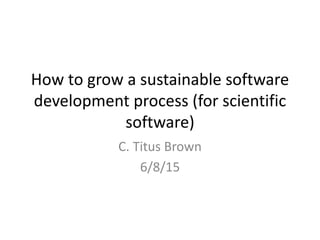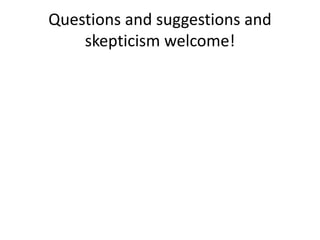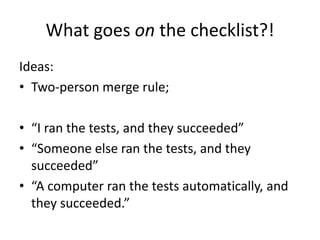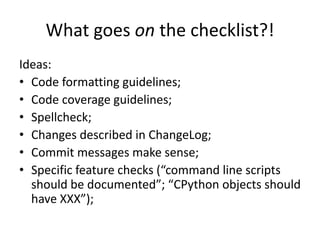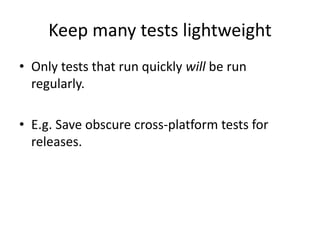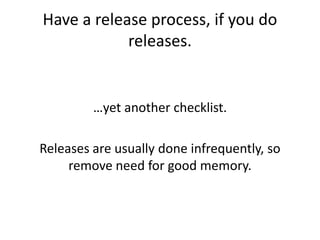2015 msu-code-review
- 1. How to grow a sustainable software development process (for scientific software) C. Titus Brown 6/8/15
- 2. Questions and suggestions and skepticism welcome!
- 3. The khmer project • ~13k lines of C++, ~7k lines of Python • About 8 years old • ~5 regular developers, ~60 contributors total • Formal dev/contrib process (khmer.rtfd.org) • We took a circuitous path… see “Walking the talk” http://dx.doi.org/10.6084/m9.figshare.791567
- 4. Example (Creating a new pull request)
- 5. A simple three step process. 1. Use version control and create branches for each feature set. 2. Make up a checklist to fill out at each merge. 3. Adhere to the checklist :)
- 6. Version control With distributed VCS like git or mercurial, there is no good reason not to use version control even for small personal projects. Version control will save your bacon.
- 7. A checklist
- 8. What goes on the checklist?! Ideas: • Two-person merge rule; • “I ran the tests, and they succeeded” • “Someone else ran the tests, and they succeeded” • “A computer ran the tests automatically, and they succeeded.”
- 9. What goes on the checklist?! Ideas: • Code formatting guidelines; • Code coverage guidelines; • Spellcheck; • Changes described in ChangeLog; • Commit messages make sense; • Specific feature checks (“command line scripts should be documented”; “CPython objects should have XXX”);
- 10. Important thing about these rules: Target things that are causing you pain. • There are an infinite number of edges to sand down on any reasonably involved software project! • Focus on the painful edges.
- 11. (Running the tests.) (Continuous Integration)
- 12. Testing I don’t personally do Test Driven Development, although I’m happy to work with people who do. “Test-Enhanced Development” – 1. Write really simple tests that cover most of the new code, along with any tricky bits that you were worried about when writing the code (~TDD-lite). 2. Then do SDD.
- 13. “Stupidity Driven Development” • Wait until something breaks (user report, bug found, whatever). • Write a test that triggers that bug. • Then, and only then, fix the bug. That exact bug will never reappear guise in the codebase :)
- 14. Code coverage Use code coverage as a guide to writing new tests. If a line if code isn’t executed by your tests, then it’s not tested by your tests. (Just because it’s successfully executed by your tests doesn’t mean it’s correct!)
- 15. Random advice
- 16. Automate your tests • Anything that isn’t automated won’t be run regularly, if at all.
- 17. Keep many tests lightweight • Only tests that run quickly will be run regularly. • E.g. Save obscure cross-platform tests for releases.
- 18. Set up continuous integration, maybe? • Very useful for cross-platform testing, integration testing… • …but people should be running the tests before they commit, and certainly before they push.
- 19. Have a release process, if you do releases. …yet another checklist. Releases are usually done infrequently, so remove need for good memory.
- 20. Never rewrite both your tests and your code at the same time. Otherwise you’ll not only invent exciting new bugs, but you’ll reimplement boring old ones!
